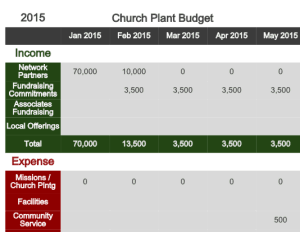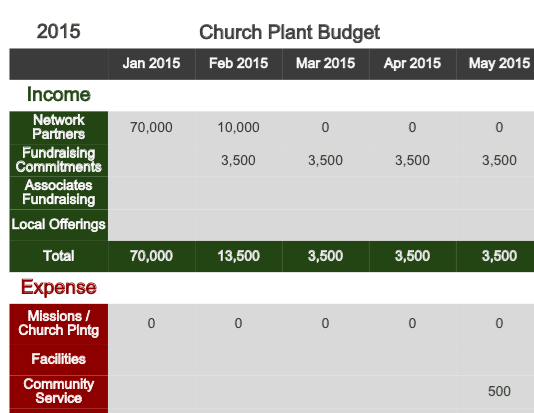
One of the most important things you will do as you plant your church is create a church plant budget. Here are some things to keep in mind as you do:
It’s About Vision
Your budget document is less about money than it is about vision. When you create a church plant budget, you are forced to make decisions about what initiatives and programs get the church’s limited funds, and which do not. You will decide how to ‘do church’ by how you allocate your resources. Your budget needs to support the vision: people quickly discover those areas where you didn’t put your money where your mouth is.
2 Sides to Every Budget
I see a lot of first draft budgets that only include expenses. Perhaps in your family’s budget you don’t give much thought to the income because it’s the same every month. But as you create a church plant budget, there are usually several streams of income, and they’re always changing.
Create several income lines and label them after each potential source of income. You have to forecast your income in your budget; just base it on the best information you have.
Likewise, create about a dozen expense lines and think of the broad categories in which you’ll spend money. The picture above will help you get started.
Timing is Everything
Another common mistake in first drafts is budgeting every line on an annual basis. This opens the door to several errors:
- Planning to spend the money before it comes in – you want to buy your AVL equipment in June but your sponsor church isn’t sending the big check until August
- Calculating the wrong total – your rent is going to be $1,000/month, so you budget $12k for the year; but you don’t start renting until September, so you really only need $4,000
- Misaligned start dates – does the ‘first year’ of your budget start on Jan 1, on your hire date, or at the Grand Opening of Sunday services? I’ve seen budgets with some of each, which makes budgets crash hard
Here’s how to fix this problem: start with you income & expense categories in rows (as above) and then lay out your budget in 12 monthly columns that match the new church’s fiscal year (I recommend using the calendar year as your fiscal year; keeps things simple). Plot your figures in the month you think they’re going to fall (like in the picture above).
Get it Approved
Everyone answers to some authority. Whoever that is, get your budget in front of them. Encourage them to ask questions and hold you accountable to it. And then work with your bookkeeper or accountant to create reports every month on how you did.

Leave a Reply